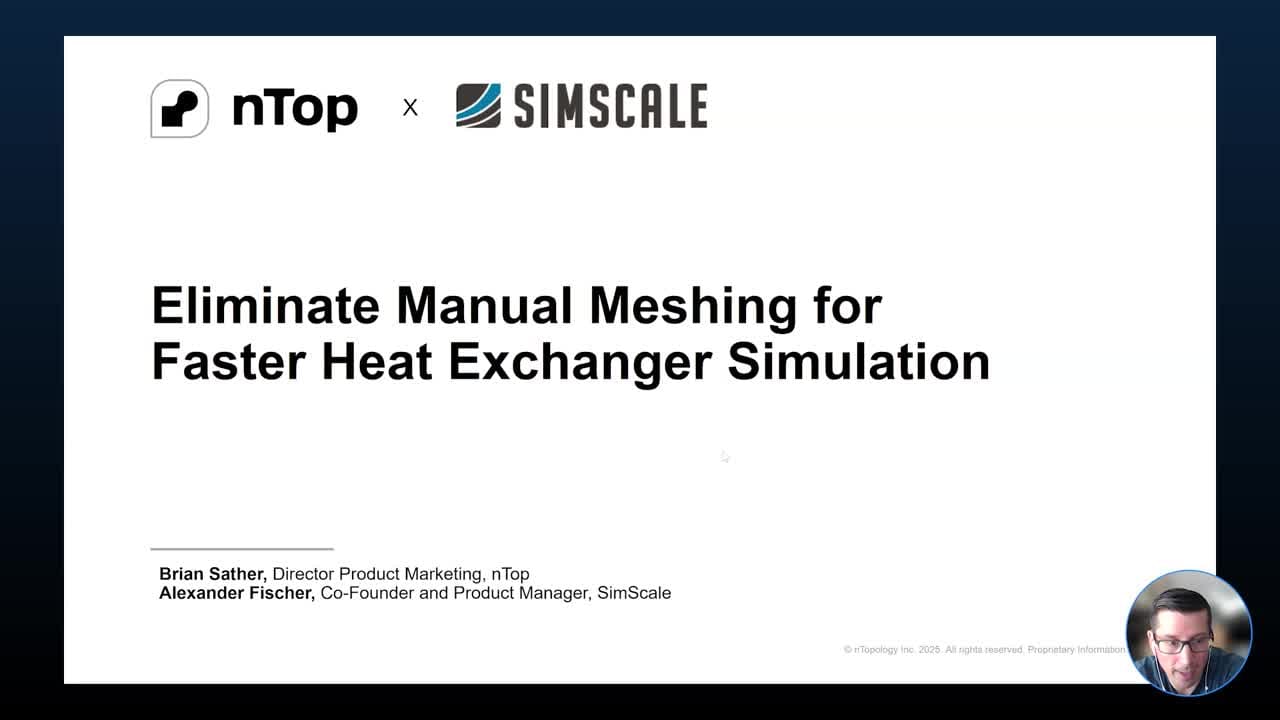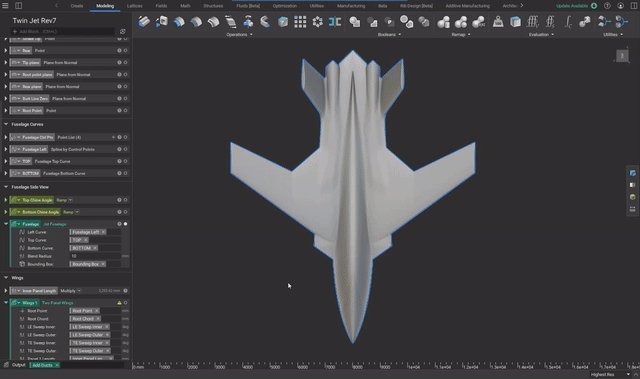Field-Driven Design: Product data models for rapid, collaborative development

Written by nTop
Published on March 4, 2019
The increased sophistication of today’s products and the introduction of advanced manufacturing creates an unprecedented level of complexity across engineering disciplines. In particular, technologies that improve performance and efficiency, promote part consolidation, and use advanced manufacturing all create challenges for design, simulation and manufacturing teams.
The increased sophistication of today’s products and the introduction of advanced manufacturing creates an unprecedented level of complexity across engineering disciplines. In particular, technologies that improve performance and efficiency, promote part consolidation, and use advanced manufacturing all create challenges for design, simulation and manufacturing teams.
The unifying language of fields
A new approach to multifunctional design using fields encapsulates shape, physics, and manufacturing process in a single unified environment. Engineers can now overlay CAD geometry, simulated and empirical engineering data, and manufacturing process knowledge to design highly fit, knowledge-driven, application-specific components that scale from the lab to predictable, repeatable production.
Engineering and manufacturing is filled with fields. By “fields” we mean information about positions in space, such as distance, forces, and velocities. It turns out that almost all kinds of engineering data can be consolidated in the language of fields. Not only do CAD, CAE, and CAM translate to fields, but users can also directly describe the operating environment to create or modify designs.
Fields represent geometry
Although traditional boundary representation, or B-rep for short, and mesh-based CAD systems do not speak the language of fields, CAD models can be converted to an implicit distance field representation to enable robust and fully automated modeling, as recently discussed in this post.

Implicit field of an octet lattice structure with nodal fillets. This field extends through 3D space and stores part geometry in exact form, allowing failure-proof and nearly-instantaneous offset and blend operations. The concepts of tolerance only apply upon exporting to an image, mesh for further simulation, or tool paths for manufacturing.
Some generative technology, such as topology optimization, directly produces a field output in the form of density or distance-like fields. Even data such as point clouds and volumetric scans can be evaluated as fields without time consuming reconstruction.
Fields are the language of physics
Most types of engineering simulation, such as finite element analysis and computational fluid dynamics, use fields as their main input and output language. Each kind of solver takes boundary condition input (which generalize as fields) and produces fields as output. For example:
- Structural solvers produce stress, strain, and displacement fields.
- Thermal solvers produce temperature fields.
- Modal solvers produce structural fields as a function of frequency.
- Fluid dynamic solvers take flow rates and generate potential and velocity fields.
- Electromagnetic solvers work with forces, currents, and electromagnetic fields.

Two loading conditions of a beam can be combined using superposition to produce a lightweight lattice that addresses both cases. Test specimens, such as the models created in nTop above, can confirm the theory in simple cases and then apply it to arbitrary part geometry from CAD with loading from CAE.
Fields enable collaboration and automation
Traditional CAD, CAE, and CAM tools, by definition, focus on one part of the engineering process. In addition, the engineering software stack is fragmented resulting in data models that are also fragmented. In practical use multiple models are needed for design, simulation, and manufacturing. In all but the smallest companies, such roles are typically handled by specialists in disparate roles.
Geometric constraints and engineering requirements should directly drive manufacturing output, bypassing many of the iteration loops and inefficiencies associated with traditional processes. The first step in making that happen is to realize that CAD-heavy processes can lock down engineering prematurely. Before committing to detailed designs in CAD, each discipline should bring their expertise as an input to the process. Typically, there are three kinds of inputs:
- Geometric input includes concept models, the space or “envelope” in which the part may exist, mounting points and mating geometry, and aesthetic, aerodynamic, or other sacrosanct surfaces.
- Engineering input consists of simulated and empirical data about the operating or environmental conditions imposed on the part, some of which may be known a priori or learned post facto from prototyping.
- Manufacturing input can simply be simulated or measured distortion and process-specific constraints. In advanced manufacturing, it can include generative rules and sophisticated models that automate the creation of lattices, infill geometries, and compensation, preparation, and fixturing for post processing.
In field-driven design, users overlay the design, analysis, and manufacturing disciplines into one engineering model. Field-based geometry, simulation, and manufacturing algorithms can then leverage those fields to generate consistent and predictable results. This approach enables orders of magnitude increase in design iteration speed.
In the field-based world, CAD continues to drive and document input geometry, while topology optimization enables a smooth representation of both shape and internal forces. Known environmental factors such as forces, pressures, displacements, and conductive heat transfer can overlay the nominal geometry, and effects that must be measured from prototypes, such as modal effects and convective heat transfer, can be layered on once known.

Topology optimization is a convenient technique to synthesize both shape and force fields simultaneously. nTop smooths the fields to create curvature continuous surfaces and combine the results with the original CAD geometry, eliminating the need for any tedious and often-manual post-processing of topology optimization results. Finally, empirical process knowledge can use those fields to fine tune sliced output for manufacturing.
In advanced manufacturing, the manufacturing team has the most to contribute to the engineering process. Where traditional manufacturing may allow a one-way workflow from design to production, the role is reversed with advanced manufacturing. Engineers must do bench work to qualify and characterize the new processes and are the first to learn how to apply them to engineering problems. The challenge is how to share such knowledge with the rest of the engineering, design, and analysis team. The answer is fields, which provide the common language needed to overlay the manufacturing solution with the geometry and engineering problem.
Summary
With these three kinds of input fields, generative or computational design software, such as our nTop, can produce knowledge-driven CAM output as well as CAD documentation and validation input decks for CAE. These field-driven workflows capture knowledge to be applied to future designs or to become the engine of an automated manufacturing process.
The benefits of field-driven design and unifying the technical language between engineering disciplines are substantial. Improved collaboration and data flow between teams is a major benefit, where specialized knowledge can be shared and efficiently utilized across an organization instead of product decisions made in silos. In addition, there is an order of magnitude speed increase for trade studies and design iterations. Both of these benefits and more will be discussed in future nTop blog posts and informational sessions.
If you would like to learn more about field-driven design and how nTop is addressing today's engineering problems, we invite you to request a demo. We'll further explore this topic by showing examples of knowledge sharing that results in more sophisticated, highly engineered products.

nTop
nTop (formerly nTopology) was founded in 2015 with the belief that engineers’ ability to innovate shouldn’t be limited by their design software. Built on proprietary technologies that upend the constraints of traditional CAD software while integrating seamlessly into existing processes, nTop allows designers in every industry to create complex geometries, optimize instantaneously, and automate workflows to develop breakthrough parts and systems in record time.




